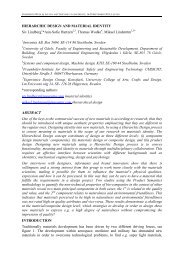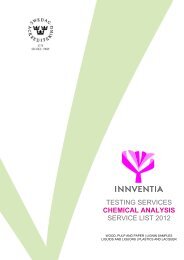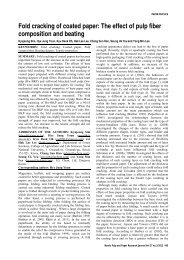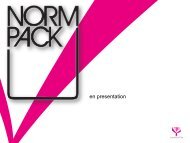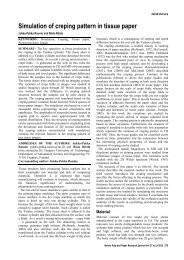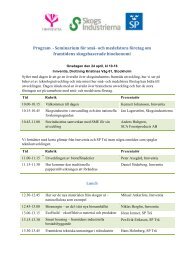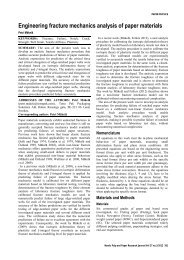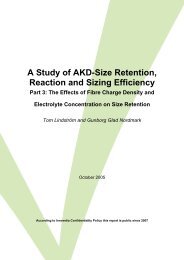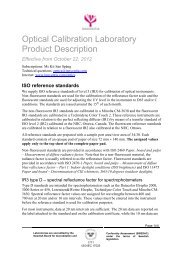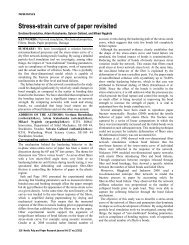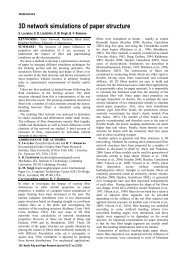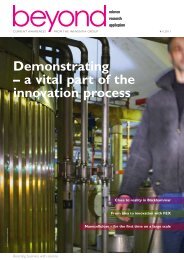Beyond 2, 2005 - Innventia.com
Beyond 2, 2005 - Innventia.com
Beyond 2, 2005 - Innventia.com
- No tags were found...
Create successful ePaper yourself
Turn your PDF publications into a flip-book with our unique Google optimized e-Paper software.
Ewa Lie and Anne Stockenberg are two of the researchers at theSTFI-Packforsk microbiology laboratory. According to them, thelaboratory is expertly equipped to carry out all kinds of microbiologicalanalyses.Is there lifein paper?Is there life in paper after a papermachine? This question may beanswered in various ways, e.g. apaper’s manner of expressing itselfor its tendency to change.The expert microbiologists at the STFI-Packforsk microbiology laboratory studythe life that, of itself, exists in paper;micro-organisms that can not only beinjurious to health when <strong>com</strong>ing in contactwith food products but that maycause costly interruptions to productionin the manufacturing processes. Thereare certain organisms that can evenform resistant spores. These are calledendospores and may remain even afterthe drying section of a paper machine.“One sign of the survival capabilityof an endospore is that they are whatresearchers are in quest of, when lookingfor life on Mars,” says Ewa Lie who isresponsible for work in the microbiologylaboratory. “Micro-organisms can be thecause of slime being formed which, inturn, can give rise to spots or holes in apaper and, in the worst instance, cause aweb break. They can also cause corrosiondamage to process equipment.”According to Ewa Lie, it is quite <strong>com</strong>monfor a mill to try to elude a problemby adding more chemicalsto stop the work of theorganisms. This, however, ismerely a way of treating thesymptom rather then curingthe cause of the disease.If there are problemswith processes or production,it can be beneficial tocarry out a system analysisto find potential problemorganisms.“In principal, this meanslooking at the process equipmentwith microbiologicaleyes,” adds Ewa.Since micro-organismsare living matter that performdifferently, dependingon their environment, therecannot be a <strong>com</strong>mon solutionto every problem. Byusing tailor-made methodsadapted to the environmentof a particular mill, there is abetter chance of finding thesource of a problem in themicrobiology laboratory.One of the latest methodsis to look at non-cultivablebacteria with the assistance of molecularmethods.Customer demands on foodstuff packaging,without the presence of substanceshazardous to health, has put focus onproduction processes but from a microbiologicalperspective.Ewa concludes, “At STFI-Packforsk,we are more than prepared to meet newdemands from the industry for excellentand reliable testing methods based on ourfrontline research.”•CONTACT: ewa.lie@stfi.seDet mikrobiologiska laboratorietvid STFI-Packforsk studerar de levandemikroorganismer som finns i papperet ochsom inte bara kan vara hälsovådliga i kontaktmed livsmedel utan också kan orsakakostsamma produktionsstörningar i tillverkningsprocessensom t ex slembildningoch korrosionsskador. En vanlig åtgärd äratt tillsätta kemikalier för att stoppa organismerna,säger Ewa Lie som leder arbetetinom laboratoriet, men enligt henne botarman då endast symptomen. Ett bättre sättär att göra en systemanalys för att hittaeventuella problemorganismer.Eftersom mikroorganismer är levandemateria som uppträder olika beroende påomgivningen, kan man inte ha en generelllösning för varje problem. Genom skräddarsyddametoder som är anpassade fördet enskilda brukets miljö, har man påmikrobiologilaboratoriet bättre möjligheteratt hitta källan till problemen.ProfileAnneStockenbergAnne Stockenberg is a Major ProjectManager and one of the experts at STFI-Packforsk in the field of microbiology.Working with the forest industry wassomething quite new to her when shetook up her appointment in the Companythree years ago. During her time at theMicrobiology Department at StockholmUniversity, it was the sea rather than theforest that was her focus when she studiedhow microbial processes in the sedimentaffect eutrophication in the BalticSea, among other things.When asked why it is interesting towork with micro-organisms, she repliesthat they are fascinating.“It is an invisible world that influencesan incredible number of things.” she says.She describes an old branch of learningwith classical methods that have undergonedevelopments in the last thirty yearsthrough the influence of molecular biology.It has provided us with new tools forstudying micro-organisms. As a result, it ispossible to see that the microbial world ismore sophisticated and diverse than waspreviously believed.“New species and types have been discovered,which has meant, among otherthings, that the evolutionary developmenttree has had to be redrawn,” she says.Anne began her studies in humanities,with a deep interest in languages. Afterthis, she spent many years abroad, inChile, Algeria and Cuba. However, whenshe changed her profession to science in1987, it was as if an entirely new worldhad opened up to her. Nevertheless, sheviews her humanities background as a<strong>com</strong>plete asset. It makes it possible forme to have a broader perspective, to seeproblems from different aspects.”Her interest in biology is given furtherexpression when, in her leisure time, shelikes to potter in her own garden at hercountry place in Västmanland.•CONTACT: anne.stockenberg@stfi.se2 | <strong>Beyond</strong> #2/<strong>2005</strong> Current awareness from STFI-Packforsk



